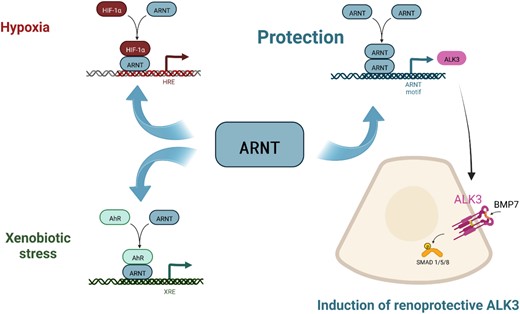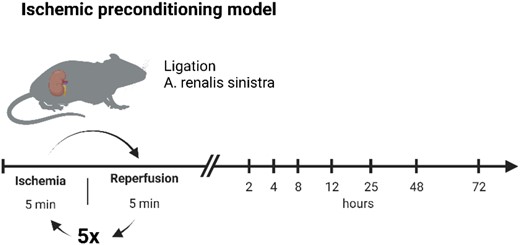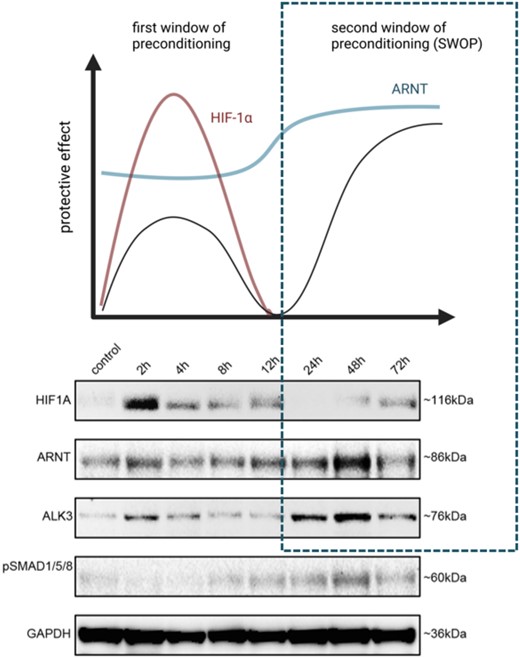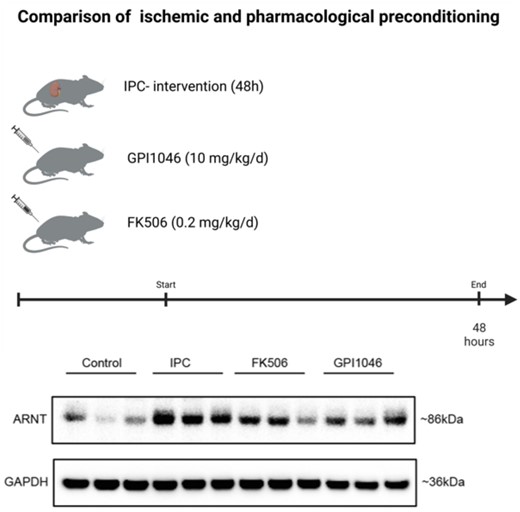-
PDF
- Split View
-
Views
-
Cite
Cite
Gregor Christof Rapp, Michael Zeisberg, Gunsmaa Nyamsuren, #6635 ARNT AND ALK3 MEDIATE RENO PROTECTION AFTER ISCHEMIC PRECONDITIONING, Nephrology Dialysis Transplantation, Volume 38, Issue Supplement_1, June 2023, gfad063c_6635, https://doi.org/10.1093/ndt/gfad063c_6635
Close - Share Icon Share
Abstract
Ischemia and following hypoxia are a common cause of acute kidney injury (AKI). Strategies for prevention and treatment of AKI are limited. In several animal models, ischemic preconditioning (IPC) has been established as an effective intervention to prevent ischemic organ injury. An IPC protocol of ischemia and reperfusion mediates organ protection for a few hours. This first phase of organ protection is followed by a second, protective phase occurring after 24–48 h. The second phase, named second window of protection (SWOP), persists for 3–4 d. Mechanisms and transcriptional mediators during SWOP are mostly unknown. The aim of the underlying study was to investigate effectors and target genes during SWOP and to identify a potential pharmacological therapeutic target.
6–8-week-old C57BL/6 mice were undergoing an IPC intervention; five minutes of renal sinistra artery ischemia was followed by five minutes of reperfusion. This cycle was performed five times. Mice were sacrificed 2, 4, 8, 12, 25, 48, 72 h after IPC. Two additional groups of mice were pharmacologically preconditioned for 48 h with low dose FK506 and small molecule GPI1046. Analysis of murine kidneys were performed by SDS-Page and Western blot.
The first phase after IPC (2–4 h) was characterized by an increasing expression of hypoxia inducible factor-1α (HIF1α); 48 h after intervention a significant increase of expression of aryl hydrocarbon receptor nuclear translocator (ARNT) and consecutive activin receptor-like kinase 3 (ALK3) was observed. Comparable induction of ARNT and ALK3 expression was obtained by pharmacological preconditioning with FK506 or GPI1046.
Affected by hypoxia, HIF1α activates transcriptional upregulation of ARNT 48 h after IPC. The increasing expression of ARNT, follows an increased ARNT homodimerization. ARNT homodimer binds to the palindromic E-box 5′-CACGTG-3′ of the proximal ALK3 promoter. By this it induces the expression of the renoprotective ALK3 during SWOP. The organ-protective effects of constitutively expressed ARNT during SWOP can be mimicked pharmacologically by administration of FK506 or GPI1046 and may be used as a future therapeutic target.

Schematic illustration of the multiple role of ARNT. Under hypoxia or xenobiotic stress, ARNT is the functional heterodimeric binding partner of aryl hydrocarbon receptor (AHR) or HIF-1α. In tubular epithelium, ARNT homodimers induce transcription of ALK3 and consecutively mediate regenerative and antifibrotic effects via the canonical pSMAD1/5/8-signaling cascade. Created with BioRender.com.

Schematic illustration of IPC protocol.
Created with BioRender.com.

Robust induction of ARNT and ALK3 expression 48 h after IPC intervention. (A) Schematic illustration of the effectors (HIF-1α, ARNT) during SWOP. (B) Representative Western blot showing protein levels of HIF-1α, ARNT, ALK3 and pSMAD1/5/8 in murine IPC kidneys at different post-intervention time points (2, 4, 8, 12, 25, 48 and 72 h). Created with BioRender.com.

Pharmakologische Induktion der Expression von ARNT. (A) Schematic illustration of study design. (B) Representative Western blot showing protein levels of ARNT in murine IPC kidneys (48 h) and kidneys after pharmacological preconditioning with low dose FK506 or with the small molecule GPI1046. Comparable induction of ARNT expression was obtained by pharmacological preconditioning with FK506 or GPI1046. Created with BioRender.com
- ischemia
- ischemic preconditioning
- signal transduction
- transcription, genetic
- western blotting
- hypoxia
- reperfusion therapy
- physiologic reperfusion
- renal failure, acute
- epithelium
- activin receptor
- mice, inbred c57bl
- animal model
- aryl hydrocarbon receptor
- up-regulation (physiology)
- xenobiotics
- kidney
- mice
- pharmacology
- stress
- tacrolimus
- candidate disease gene
- small molecule
- binding (molecular function)
- prevention
- sodium dodecyl sulfate-polyacrylamide gel electrophoresis





Comments